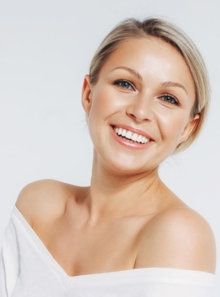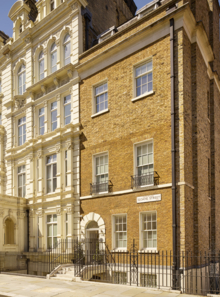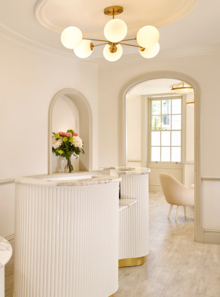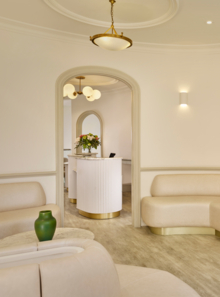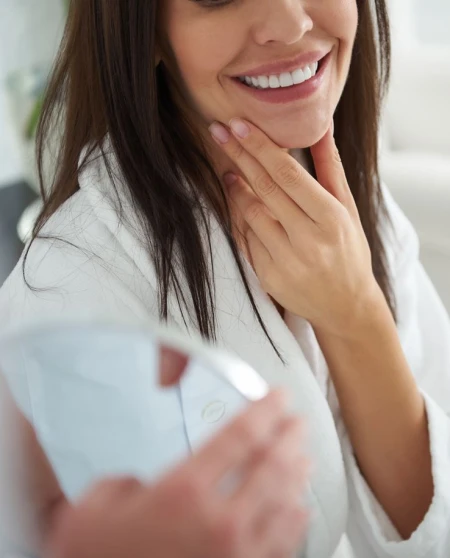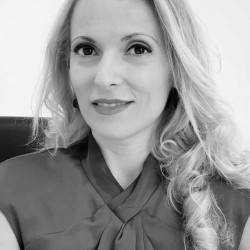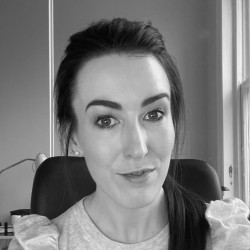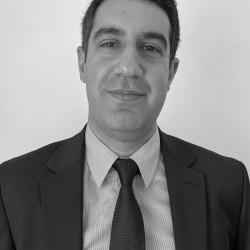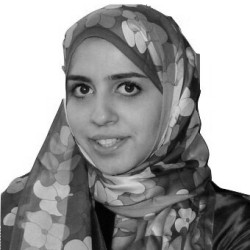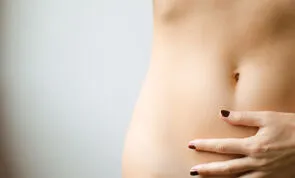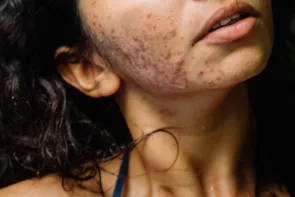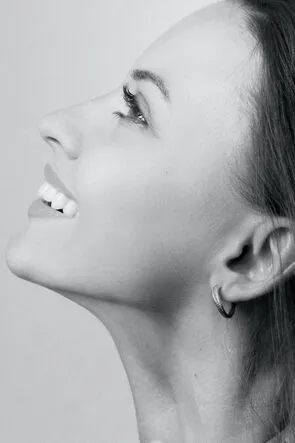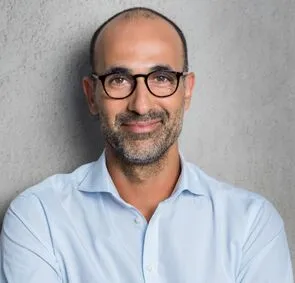Medically Reviewed November 2023,
by Dr. Susan Mayou (GMC: 2405092) - founder of the Cadogan Clinic and one of the world's leading dermatologists
What are Milia?
Milia are tiny cysts, measuring just one or two millimetres in size, and are characterised by small, white or yellow dome-shaped bumps. Milia can sometimes be mistaken for whiteheads, a type of acne. However you should never squeeze a milium cyst. Milia occurs when keratin becomes trapped beneath the surface of the skin. Keratin is a strong protein that's typically found in skin tissues, hair, and nail cells. In comparison, whiteheads are filled with dead skin cells, bacteria and sebum. A person can still develop milia even if they are not prone to inflammatory acne.
Milia are not usually itchy or painful, but may cause discomfort for some people, with rough sheets or clothing rubbing on the milia causing them to appear red and irritated. Others find these little white bumps unsightly and their presence can have a negative impact on a person’s self-confidence and self-esteem.
Milia cysts are typically found on the face, lips, eyelids, and cheeks, but they can sometimes be found on other parts of the body, such as the torso or genitalia. They may also appear along the nasal crease in young children. Milia usually appear in clusters. Milia can affect adults and children of all ethnicities, sexes and ages. However milia is more commonly found in newborn babies.
Get in touch
Why do people have it?
Milia are mainly an aesthetic concern and often resolve on their own over time. Milia are rarely itchy or painful, but some may experience mild discomfort due to this condition. Some people may feel self-conscious or anxious about the appearance of milia on their face or body and opt to have the cysts removed rather than wait for them to disappear.
If persistent or bothersome, milia may be extracted by an aesthetician or healthcare professional. If you are unsure whether a bump on your skin is a milium, it is best to consult with your doctor. The dermatologists here at the Cadogan Clinic are available for in-depth consultations to diagnose milia and provide effective treatment if required.
Who is suitable?
Milia removal is safe, effective and suitable for adults and children. If a patient is particularly prone to scarring, or at risk of hyperpigmentation or hypopigmentation, the Cadogan Clinic’s team of plastic surgeons works closely with our expert dermatologists.
Cryotherapy is considered to be safe for pregnant women. Our specialist dermatologists here at the Cadogan Clinic can advise on the most appropriate milia removal treatment option for you and talk through any concerns you may have.
In babies, milia clear up naturally within a few weeks and no treatment is required.
The cost of Milia Removal
Dermatologist-led: Our milia removal service is dermatologist-led, meaning that every milia removal patient is seen and treated by a trained dermatologist.
Plastic surgeon-supported: We have a team of fifteen plastic surgeons who provide support to our dermatology team for more complex removal cases or reconstructions, or in cases where the patient is particularly sensitive to scarring.
Rapid, same-day removal: We are able to offer rapid, same-day removal of milia due to our three fully staffed on-site theatres here at our Chelsea-based clinic.
What are the different types of Milia?
Neonatal milia
Often referred to as baby milk spots, these are milia that are seen in young babies soon after they are born. They are very common and are usually found around the nose area but may also occur on the scalp, cheeks, upper body and inside the mouth. It is extremely common, with around half of all babies develop neonatal milia. Sometimes neonatal milia is incorrectly referred to as ‘baby acne’. Unlike baby acne, milia doesn’t cause inflammation or swelling.
Primary milia
These milia occur in both children and adults. They appear on an area of skin that has not experienced any previous damage or injury.
Secondary milia
These milia develop in an area of skin that has previously been damaged or injured, for example, skin that has been burned or blistered. The cysts may become irritated, making them red along the edges and white in the centre. The milia develop as the skin heals and it is thought that damage to the sweat glands may be an underlying cause. Secondary milia also sometimes develop after steroid creams have been used on the skin.
Milia en plaque
These types of milia cysts are extremely rare. The milia develop on an inflamed, raised patch of skin known as a plaque which may be several centimetres across. They usually appear behind the ears, on the eyelids or around the jaw area and tends to particularly affect middle-aged women. However people of any age or sex can still develop this form of milia. It is not fully understood what causes this particular type of milia, but they are sometimes associated with various skin disorders, such as pseudoxanthoma elasticum, discoid lupus erythematosus, lichen planus.
Multiple eruptive milia
These are patches of milia that develop over a period of weeks or months, usually on the face, upper arms and the upper trunk. Milia of this type are also extremely rare.
Juvenile milia
Rare genetic disorders that affect the skin can sometimes lead to what is known as juvenile milia. These may be present at birth or develop later in life. These disorders can include:
- Nevoid basal cell carcinoma syndrome (NBCCS). NBCCS can lead to basal cell carcinoma (BCC).
- Pachyonychia congenita. This condition may cause a person to have thick or abnormally shaped nails.
- Gardner’s syndrome. A rare genetic disorder which may lead to colon cancer over time.
- Bazex-Dupré-Christol syndrome. This syndrome affects a person’s hair growth and their ability to sweat.
Most milia will eventually clear by themselves, however they can persist for many weeks, months, or even longer. There is really no knowing how long this process will take, so some people view milia removal as a preferable option to waiting for nature to take its course. Secondary milia are sometimes permanent.
It is important that milia are correctly diagnosed as they can sometimes be confused with other types of skin conditions, including comedones, miliaria, and other types of cysts.
How does Milia Removal work?
Here at the Cadogan Clinic, skin lumps and bumps, including milia cysts, are treated by two main techniques.
Excision removal is a painless surgical removal, carried out under local anaesthetic. The affected area is carefully cut away using a scalpel and completely removed.
Another highly-effective method employed here at the clinic is cryotherapy. In this treatment, locally applied freezing therapy employs liquid nitrogen gas to freeze the target area. The cold temperature kills the cells within the area, causing it to naturally fall off. Cryotherapy takes between 5 and 10 seconds per treatment and is usually well tolerated. You should expect to feel a localised sensation of cooling on the surface of your skin. Ongoing treatment may be required.
Surgical excision or cryotherapy will permanently remove the milia cysts targeted by treatment. It will not prevent new cysts from appearing in new locations on the skin.
Recovery time should be instant. You will be able to immediately resume daily activities in most cases. Complications from these procedures are rare.
In the case of milia en plaque, a rare form of milia, certain creams such as isotretinoin or tretinoin are sometimes suggested as treatment, or the antibiotic tablet, minocycline.
Cadogan Clinic. A strong tradition of innovation

Founded in 2004 by world renown dermatologist Dr Susan Mayou, we now work with over 100 leading consultants and successfully treat over 20,000 patients each year. We have been winning industry awards since inception.
Get in touch
Milia Removal Surgeons
We have invited a selection of the country's very best consultants to join us at the Cadogan Clinic so that you can be sure that whatever the nature of your treatment, you will be seeing one of the top practitioners in the country.
Frequently Asked Questions
What causes milia?
In adults and older children, milia cysts are typically caused by damage to the skin.
Things that may cause damage to the skin, prompting milia to develop, include:
- Blistering due to a skin condition, such as epidermolysis bullosa (EB), cicatricial pemphigoid, or porphyria cutanea tarda (PCT)
- Blistering injuries, caused by poisonous plants
- Burns
- Sun damage
- Long-term use of steroid creams
- Skin resurfacing procedures, such as dermabrasion or laser resurfacing
Some ingredients in skincare products and make-up can trigger milia in some people. A person who has milia-prone skin may want to try and avoid the following ingredients in beauty products:
- Liquid paraffin
- Liquid petroleum
- Paraffin oil
- Paraffinum liquidum
- Petrolatum liquid
- Petroleum oil
These are all types of mineral oil that may cause milia. Lanolin, a waxy substance used to treat or prevent dry, rough, scaly, itchy skin and minor skin irritations such as nappy rash and cracked nipples caused by breastfeeding, may also increase the formation of milia.
Milia can also develop if the skin loses its natural ability to exfoliate. This can happen as a result of aging when the skin’s collagen levels deplete. Milia can also be a side effect of chemical peels, although measures can be taken to lessen the likelihood of this occurring.
Babies who have milia cysts are usually born with the condition. These milia are believed to be caused by sweat glands that aren't fully developed or mature.
These are harmless and usually go away within a few weeks of birth.
How do I get rid of my milia?
There are no effective home remedies for the treatment of milia.
Although milia are found in the outer layers of skin, they are difficult to remove without the correct tools. You should never attempt to squeeze or pick milia cysts. Milia are hard little bumps and because they form under a thin layer of skin and not in the pore like acne blemishes, they do not have an opening onto the skin’s surface from which to escape. Any attempt to ‘pop’ milia cysts could result in infection and permanent scarring. We don’t recommend trying to prick milia cysts with a needle or pin yourself as this also presents a high risk of infection, particularly if the pin or needle used is not sterile.
The best way to rid yourself of milia is by cryotherapy or excision removal by a medical professional in a clinical setting. We offer both these milia removal treatments here at the Cadogan Clinic.
What is the best milia removal treatment?
Excision removal is perhaps one of the most effective treatments for milia removal. This sees the milia carefully removed from the body with a surgical scalpel following the administration of a local anesthetic. This process is quick and painless. Patients can return to their day-to-day routine immediately after this treatment.
Cryotherapy is also an option for milia removal. In cryotherapy, liquid nitrogen is applied to the affected area for a few seconds to freeze and destroy the affected skin cells. After treatment, a sore blister will form, followed by a scab, which will fall off a few days after the treatment.
A session of cryotherapy is quick, with patients able to leave the clinic and carry on with their day immediately after milia removal treatment. However some people can find cryotherapy treatment painful, although it is usually well-tolerated.
There are two different cryotherapy methods. Liquid nitrogen may be sprayed directly onto the affected area, or it may be applied to the milia using a stick with cotton wool on the tip. Potential side effects include localised pain, blistering and the skin may become darker (hyperpigmentation) or lighter (hypopigmentation). This risk is higher for patients with black skin.
Cryotherapy is considered a safe milia removal treatment for pregnant women.
The type of milia removal treatment will depend on whereabouts on the body the milia is located and the size of the affected area. Book a consultation with one of the Cadogan Clinic’s expert dermatologists to discuss the best treatment option for you.
What are the various milia treatments available?
There are various milia removal treatments available, including topical retinoids which help to exfoliate the skin, chemical peels, laser ablation, diathermy, which utilises extreme heat to destroy the cyst, and a surgical scrape and cauterisation.
However, we do not offer these treatments here at the Cadogan Clinic because we believe these methods are either too harsh on the skin or simply not effective. We carry out cryotherapy and excision removal as we believe these are by far the most effective milia removal treatments and pose the lowest risk of any skin damage.
Milia should not be squeezed or pricked with a pin. You could cause some serious skin damage, particularly around the delicate eye area where the skin is thinner.
We do not recommend treating milia at home.
How do I prevent milia?
Primary milia can't be prevented, nor can secondary milia from causes which cannot be avoided, for example blistering injuries.
However there are steps which can be taken to lessen the likelihood of developing secondary milia.
- Protect skin from excessive exposure to the sun. Use a high-protection sunscreen.
- Thoroughly remove all traces of make-up before going to bed. Oily eye make-up removers are best avoided if possible. A micellar water may be a more gentle option.
- Exfoliate two or three times a week to help clear away dead skin cells.
- Clean the affected area daily. Use a mild soap to prevent skin irritation.
There are also certain lifestyle factors which could make a person more prone to developing secondary milia. These include a lack of sleep and smoking. Some experts have suggested that limiting intake of cholesterol-rich foods and incorporating vitamin D supplements into your diet may help to reduce the likelihood of milia developing. Even if these measures don’t ultimately protect you from developing milia, we would always advocate a healthier diet, good quality sleep and quitting smoking to improve overall health.
There has been some research that suggests that extracts of rose, cinnamon, and honey have antibacterial properties that can tackle some skin problems. However, there has been no research on their effectiveness with milia.
Do not try to pick or squeeze milia with your hands or use any tools or objects in an attempt to remove these tiny cysts. By doing so, you are increasing the risk of infection and could potentially be left with some nasty scars.
Here at the Cadogan Clinic, we treat thousands of skin lumps and bumps cases each year, including milia. Our team of nine highly experienced specialist dermatologists have been handpicked to form one of the best independent dermatology units in the country. Our purpose-built dermatology clinic is conveniently located off Sloane Square.
The Cadogan Clinic’s team of experts will be happy to talk you through the treatment options open to you. Get in touch today to book a consultation with one of our dermatologists for an in-person assessment of your skin.
How To Find Us
The Cadogan Clinic is based at 120 Sloane Street in Chelsea, just off Sloane Square and the Kings Road.
We are accessible by all major bus routes that pass through Sloane Square and Sloane Street, as well as Sloane Square tube station.
We are just a 5 minute walk northwards up Sloane Street once you have arrived at Sloane Square.
Local pay parking is available just around the corner from the Clinic on Cadogan Gate, Cadogan Square and Cadogan Gardens. Our local residential parking zone is the Royal Borough of Kensington & Chelsea.
Address: 120 Sloane Street, Chelsea, London, SW1X 9BW
![]() Aesthetics Medicine Awards
Aesthetics Medicine Awards![]()



